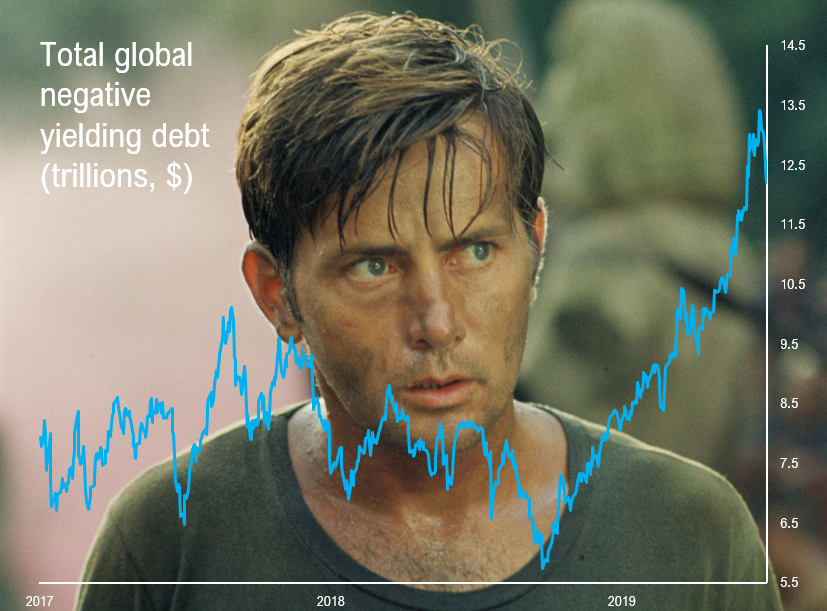Captain Willard: They told me that you had gone totally insane, and that your methods were unsound.
Colonel Kurtz: Are my methods unsound?
Captain Willard: I don’t see any method at all, sir.
– Apocalypse Now, 1979
 The horror. Data courtesy of Bloomberg
The horror. Data courtesy of Bloomberg
Were special operations officer Benjamin Willard to be sent into the concrete jungles of the Square Mile, Manhattan, or Frankfurt today, he would encounter horror, just as he does in Apocalypse Now – albeit of a different variety.
For Willard’s character, played by Martin Sheen in the classic film, is a man of the 60s. A time when the idea of being paid to borrow money would have – quite rightly – been viewed as insanity.
But as the chart above illustrates, such ideas are now par for the course. In the bond market, some ten trillion quid’s worth of bonds around the world now pay a negative yield. Leading the charge in this mad effort is Europe, where an incredible 64% of all EU government bonds pay less than nothing.
(To clarify for any new readers, investors who buy negative yielding bonds and wait for full repayment of interest and principal when the loan matures, will at the end of the exercise be sitting on a loss – and that’s not even accounting for the risk of inflation or default.)
How times change. One can only imagine the reaction of Captain Willard were he to infiltrate an investment bank in the City and discover the latest “Perverse… but not completely crazy” horror to arrive in the bond market:
Negative-yielding “high-yield” bonds.
Yes, you read that right.
High-yield bonds, or “junk” bonds, are debts to companies with a poor credit score, or “credit rating”. Investors will lend to such companies, but demand a higher return for the risk they are taking, and so the bonds pay higher yields. Or… they used to, at least. From The Wall Street Journal:
It is a stark illustration of how ultraloose monetary policies have turned debt investing into a choice about how to lose the least amount of money.
European investors have gotten used to paying for the privilege of owning safe government bonds with negative yields, a kind of backward interest rate that shows the rate at which your money will shrink over time. Investors have also gotten used to highly rated, investment-grade companies trading with negative yields.
But junk bonds are typically risky borrowers with weaker balance sheets and often smaller businesses that may struggle to pay back what they borrow anyway.
“It is a perverse situation,” said Colin Purdie, chief investment officer for credit at Aviva Investors. “It is called ‘high yield,’ so to get a negative yield is pretty unusual. But it’s not completely crazy. For some investors, there is an acceptance that it’s not about absolute returns, but relative returns.”
Oh yes, dear reader. Paying a company that has a bad credit rating for the privilege of lending to it isn’t crazy at all…
The debt of some 14 uncreditworthy companies, including the likes of Nokia and Altice, is in such high demand that it now yields less than nothing.
One has to wonder why an investor would buy such an asset. Negative-yielding government debt at least has the benefit of being highly liquid – ie, it can be swiftly bought and sold even during periods of stress.
But this benefit does not apply to corporate bonds, let alone junk corporate bonds. The Bank of England started buying corporate bonds in the wake of the financial crisis just to get the market functioning again, as it had completely seized up. As Captain Willard might say, “I don’t see any method at all” in buying such assets.
But trying to stay sane won’t make you any money in the “heart of darkness” the bond market is yet to become. To get a glimpse of where this is going, you need only listen to those buying in these “negative-yielding high-yield bonds” – as one such “investor” interviewed by The Wall Street Journal declared that “just because something is negative yielding, that doesn’t mean it can’t get more negative yielding.”
Absolutely bonkers. But probably right.
It’s worth clarifying that none of these low credit companies have borrowed directly from the market at negative rates. They’re still paying, say, 2% in interest payments, however the market price for the bond itself has become so great that it now exceeds all repayments combined.
But a junk company, issuing negative-yielding “high-yield” bonds directly to the market is definitely on the way.
Because, for all of this craziness we’re seeing emerge in the bond market (especially in Europe)… the central banks haven’t begun cutting interest rates or resuming quantitative easing yet.
All of this madness in the credit market is merely in anticipation of it. When the likes of Powell, Carney and Lagarde really step on the gas, we’re gonna see some truly insane borrowing and lending occur.
Just imagine it – investors directly taking losses to subsidise bad companies, by paying to lend to them.
The horror. The horror…
More to come,
Boaz Shoshan
Editor, Capital & Conflict
Category: Market updates


